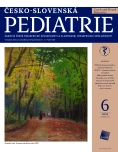Safety and changes in selected laboratory parameters in children with hymenoptera venom allergy treated with venom immunotherapy
Authors:
Kapustová Daniela 1; Bánovčin Peter 1; Kapustová Lenka 1; Petrovičová Otília 1; Malicherová Jurková Eva 1; Mikler Ján 1; Šlenker Branislav 1; Suchá Pavlína 1; Jeseňák Miloš 1,2,3
Authors‘ workplace:
Klinika detí a dorastu, Jesseniova lekárska fakulta v Martine, Univerzita Komenského v Bratislave, Univerzitná nemocnica Martin
1; Klinika pneumológie a ftizeológie, Jesseniova lekárska fakulta v Martine, Univerzita Komenského v Bratislave, Univerzitná nemocnica Martin
2; Oddelenie klinickej imunológie a alergológie, Univerzitná nemocnica Martin
3
Published in:
Čes-slov Pediat 2023; 78 (6): 308-314.
Category:
Original Papers
doi:
https://doi.org/10.55095/CSPediatrie2023/051
Overview
Introduction: Hymenoptera venom allergy is second most common cause of anaphylaxis in childhood. Currenty, the only causal therapy that can induce tolerance is venom immunotherapy (VIT). Aim: In our work, we focused on the analysis of selected clinical and laboratory characteristics in a group of pediatric patients with hymenoptera venom allergy treated with VIT.
Material and methods: We created a prospective study in which we gradually included 20 pediatric patients (13 boys, 7 girls), which fulfilled indication criteria for VIT. Data were collected from 2015 to 2022. We defined the basic characteristics of the set, we focused on the overall tolerance of treatment in pediatric patients and the occurance of adverse effects during VIT administration, we also performed blood sampling to determine the dynamics of immunological laboratory parameters in precisely determined time intervals.
Results: The mean age was 11 ± 4,37 years, with the mean age of firts systemic reactions after the hymenoptera sting 9,15 ± 3,58 years. Of the 20 enrolled patients, 14 were allergic to bee venom and 6 to waps venom. VIT was started at an average age of 10 ± 3,86 years, of which 2 patients started before the fifth year of life. The most frequently represented clinical manifestations of systemic reaction in our group were facial angioedema (70 %), dyspnea (65 %), urticaria (55 %) and whole body pruritus (45 %). We observed the occurence of the adverse effects most often during the initial phase of administration in terms of local reactions, whereas no patient developed a systemic reaction. Spontaneus re-exposure during VIT occured in 25 % of patients, whereas no patient developed a systemic reaction. During VIT we also noted dynamic changes in individual evaluated laboratory parameters with a gradual decrease of specific IgE against the extract and allergen component of hymenoptera venom and increase of specific IgG4 against the allergen extract.
Conclusion: Allergy to hymenoptera venom is classified as a serious to life-threating condition, while the only possible therapy nowadays that can prevent systemic reaction and improve the patient´s quality of life is VIT. A higher effectiveness of VIT and also a lower risk of treatment failure are described in pediatric patients. Our experencie clearly proves the effectiveness and safety of VIT in childhood and at the same time confirms positive changes in laboratory parameters indicating the induction of immune tolerance.
Sources
1. Hochmuth L, et al. Štandardné postupy diagnostiky, liečby a prevencie alergie na jed blanokrídleho hmyzu. Ministerstvo zdravotníctva Slovenskej republiky 2021. ŠP 0200.
2. Alvaro-Lozano M, et al. EAACI Allergen Immunotherapy User‘s Guide. Pediatr Allergy Immunol. 2020; 31(S25): 1–101.
3. Rybníček O, Seberová E. Průvodce alergenovou imunoterapií. Doporučení České alergologie a klinické imunologie ČLS JEP. Praha: Tigis 2021: 58–64.
4. Golden DB. Insect allergy in children. Curr Opin Allergy Clin Immunol 2006; 6(4): 289–293.
5. Tan JW, Campbell DE. Insect allergy in children. J Paediatr Child Health 2013; 49(9): E381–E387.
6. Bilo MB, Bonifazi F. Epidemiology of insect-venom anaphylaxis. Curr Opin Allergy Clin Immunol 2008; 8(4): 330–337.
7. Hershko AY, et al. Hymenoptera-venom allergy in a single-center Israeli cohort: Clinical and laboratory characteristics. J Allergy Clin Immunol 2019; 7(8): 2898–2900.
8. Yavuz ST, et al. Clinical features of children with venom allergy and risk factors for severe systemic reactions. Int Arch Allergy Immunol 2013;160(3): 313–321.
9. Schuberth KC, et al. An epidemiologic study of insect allergy in children. I. Characteristics of the disease. J Pediatr 1982; 100: 546–51.
10. Rueff F, et al. Predictors of clinical effectiveness of Hymenoptera venom immunotherapy. Clin Exp Allergy 2014; 44(5): 736–746.
11. Dhami S, et al. Allergen immunotherapy for insect venom allergy: a systematic review and meta‐analysis. Allergy 2017; 72(3): 342–365.
12. Lockey RF, et al. The Hymenoptera venom study. I. 1979–1982: demographic and history-sting data. J Allergy Clin Immunol 1988; 82: 370–381.
13. Golden DB. Insect allergy in children. Curr Opin Allergy Clin Immunol 2006; 6: 289–293.
14. Mosbech H, Mueller U. Side-effects of insect venom immuntherapy: results from an EAACI multicenter study. Allergy 2000; 55: 1005–1010.
15. Durham SR, Till SJ. Immunologic changes associated with allergen immunotherapy. J Allergy Clin Immunol 1988; 102(2): 157–164.
16. Varga EM, et al. Time course of serum inhibitory activity for facilitated allergen-IgE binding during bee venom immunotherapy in children. Clin Experiment Allergy 2009; 39(9): 1353–1357.
17. Graft DF, et al. Assessment of prolonged venom immunotherapy in children. J Allergy Clin Immunol 1987; 80: 162–169.
18. Nakai Y, et al. Effect of immunotherapy on serum levels of eosinophil cationic protein in perennial allergic rhinitis. Ann Otol Rhinol Laryngol 1997; 106(10): 848–853.
Labels
Neonatology Paediatrics General practitioner for children and adolescentsArticle was published in
Czech-Slovak Pediatrics

2023 Issue 6
Most read in this issue
- Brief resolved unexplained event (BRUE)
- Emotionally unstable adolescents – a current challenge of child psychiatry and pediatrics
- The current state of fetal imaging by magnetic resonance imaging
- Hypophosphatasia: A rare disease with an easy diagnosis and available therapy
